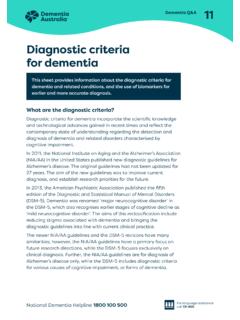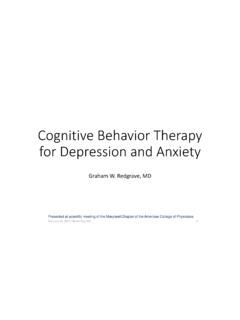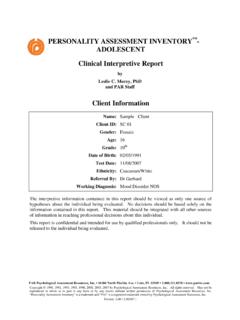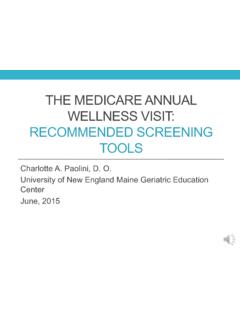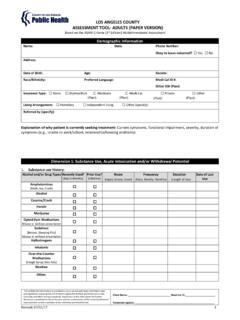Transcription of Alzheimer’s Disease: A Clinical and Basic Science Review
1 alzheimer s disease : A Clinical and Basic Science ReviewIgor O. Korolev*College of Osteopathic Medicine and Neuroscience Program, Michigan State University, East Lansing, MI, USA*Corresponding author: Igor Korolev, PhD, MSIII; s disease (AD) is the most common cause of dementia in older adults and an important public health problem. The purposeof this Review article is to provide a brief introduction to AD and the related concept of mild cognitive impairment (MCI). The articleemphasizes Clinical and neurobiological aspects of AD and MCI that medical students should be familiar with. In addition, the articledescribes advances in the use of biomarkers for diagnosis of AD and highlights ongoing efforts to develop novel : alzheimer s disease ; mild cognitive impairment ; dementia; neurodegeneration; neuroimaging; world s population is rapidly aging, and thenumber of people with dementia is expected togrow from 35 million today to 65 million by the year2030.
2 In the United States alone, 5 million or 1 in 9people over the age 65 are living with alzheimer sdisease (AD), the most common cause of dementia. Forcomparison, according to the Centers for disease Controland Prevention (2009 2012 estimates), about 3 millionolderadultsintheUnitedStateshavea sthma,10 million have diabetes, 20 million have arthritis, and25 million have hypertension. Primary care physiciansand specialists alike will encounter older adults withdementia at an increasing frequency during their dementia carries significant implications for patients,their families, and our society, it is imperative for well-rounded physicians to have a solid understanding of thistopic.
3 The purpose of this Review article is to providea brief introduction to AD and the related concept ofmild cognitive impairment (MCI). The article emphasizesclinical and neurobiological aspects of AD and MCIwith which medical students should be familiar. Inaddition, the article describes advances in the use ofbiomarkers for diagnosis of AD and highlights ongoingefforts to develop novel S DISEASEA lois alzheimer and Auguste DThe German psychiatrist and neuropathologist Dr. AloisAlzheimer is credited with describing for the first timea dementing condition which later became known asAD. In his landmark 1906 conference lecture and a sub-sequent 1907 article, alzheimer described the case ofAuguste D, a 51-year-old woman with a peculiar diseaseof the cerebral cortex, who had presented with pro-gressive memory and language impairment , disorienta-tion, behavioral symptoms (hallucinations, delusions,paranoia), and psychosocial 3 Remarkably,many of the Clinical observations and pathologicalfindings that alzheimer described more than a centuryago continue to remain central to our understanding ofAD is a Clinical syndrome (a group of co-occurring signs and symptoms)
4 That involves progressivedeterioration of intellectual cogni-tive abilities can be impaired with dementia, includingmemory, language, reasoning, decision making, visuos-patial function, attention, and orientation. In individualswith dementia, cognitive impairments are often accom-panied by changes in personality, emotional regulation,and social behaviors. Importantly, the cognitive andbehavioral changes that occur with dementia interferewith work, social activities, and relationships and impaira person s ability to perform routine daily activities ( ,driving, shopping, housekeeping, cooking, managingfinances, and personal care). Table 1 summarizes theclinical criteria for all causes of ,5 There are several reversible and irreversible causesof ,6 Reversible dementias (also referred toas pseudo-dementias ) are relatively rare but poten-tially treatable and occur secondary to another medicalcondition, including depression, nutritional deficiencies( , vitamin B12), metabolic and endocrine disorders( , hypothyroidism), space occupying lesions ( , braintumor), normal pressure hydrocephalus, or substanceReview ArticleMSRJ#2014 VOL: 04.
5 Issue: Fallepub September 2014; Student Research Journal024abuse. Certain classes of medications also have thepotential to cause cognitive impairment in older adults( , anti-cholinergics, psychotropics, analgesics, seda-tive-hypnotics). Irreversible (primary) dementias involveneurodegenerative and/or vascular processes in the is the most common cause of irreversible dementia,accounting for up to 70% of all dementia cases in theUnited types of primary dementia includevascular dementia (10 20%), dementia associated withParkinson s disease , dementia with Lewy bodies, andfrontotemporal of ADAD is a critical public health issue in the United Statesand many other countries around the world, with a sig-nificant health, social, and financial burden on estimated 5 million Americans have AD, with a newdiagnosis being made every 68 the United States,AD is the fifth leading cause of death among olderadults, and about $200 billion are spent annually ondirect care of individuals living with dementia.
6 World-wide, it is estimated that 35 million people have ADor other types of dementia, and about 65 million peopleare expected to have dementia by 2030 (115 million by2050).9AD is a multifactorial disease , with no single causeknown, and several modifiable and non-modifiablerisk factors are associated with its development andprogression. Age is the greatest risk factor for thedevelopment of AD. The likelihood of developing AD in-creases exponentially with age, approximately doublingevery 5 years after age ,11 The vast majority ofindividuals suffering from AD are aged 65 or older andhave late-onset or sporadic AD ( 95% of all cases).
7 Rare genetic mutations are associated with the devel-opment of AD before age 65, which is known as early-onset or familial AD (B5% of all cases).12 People withfamilial forms of AD have an autosomal dominantmutation in either one of the presenilin genes locatedon chromosomes 1 and 14 or in the amyloid precursorprotein (APP) gene located on chromosome 21. Inaddition, individuals with Down s syndrome (trisomy 21)have an increased risk of developing early-onset genetics of sporadic AD are more complex andless well understood. It is known that the epsilon fourallele of the apolipoprotein E (APOE) gene located onchromosome 19 is a risk factor for the developmentof sporadic prevalence of AD is higher amongfemales, reflecting the longer life expectancy educational attainment has been asso-ciated with increased risk of AD dementia,10consistentwith the idea that education serves to increase a person scognitive reserve and resilience to AD body of evidence suggests that cerebrovascularrisk factors play a significant role in both the develop-ment and progression of AD.
8 People with a history ofdiabetes, hypertension, obesity, and smoking have asubstantially elevated risk of history ofAD in first-degree relatives and a history of head injurywith loss of consciousness are also risk factors for thedevelopment of of ADAD is a progressive neurodegenerative brain disorderthat causes a significant disruption of normal brainstructure and function. At the cellular level, AD is cha-racterized by a progressive loss of cortical neurons,especially pyramidal cells, that mediate higher ,18 Substantial evidence also suggests thatAD causes synaptic dysfunction early in the diseaseprocess, disrupting communication within neural circuitsimportant for memory and other cognitive degeneration begins in the medial temporallobe, specifically in the entorhinal cortex and to these brain structures results inmemory and learning deficits that are classically ob-served with early Clinical manifestations of AD.
9 Thedegeneration then spreads throughout the temporalassociation cortex and to parietal areas. As the diseaseprogresses, degeneration can be seen in the frontalcortex and eventually throughout most of the remainingneocortex. Of note is the fact that AD causes pronouncedTable criteria for dementia1. Progressive impairment in two or more areas of cognition:a) Memory (ability to learn and remember new information)b) Language (speaking, reading, writing)c) Executive function (reasoning, decision making,planning)d) Visuospatial function (ability to recognize faces and objects)e) Praxis (ability to perform purposeful movements)f) Changes in personality, mood, or behavior2.
10 cognitive deficits:a) Interfere with functioning (ability to perform activities ofdaily living)b) Represent a decline from previous levels of functioningc) Are not due to delirium or psychiatric disorder ( ,depression)d) Are established using history from patient, corroboratedby informant ( , family member), and objective cognitiveassessmentAdapted from Ref. [5].Igor O. KorolevAlzheimer s DiseaseMSRJ#2014 VOL: 04. Issue: Fallepub September 2014; Student Research Journal025damage to multiple components of the limbic sys-tem,12,21including the hippocampal formation and themajor fiber tracts that connect it to the cerebral cortex(fornix and cingulum), amygdala, cingulate gyrus, andthalamus.

